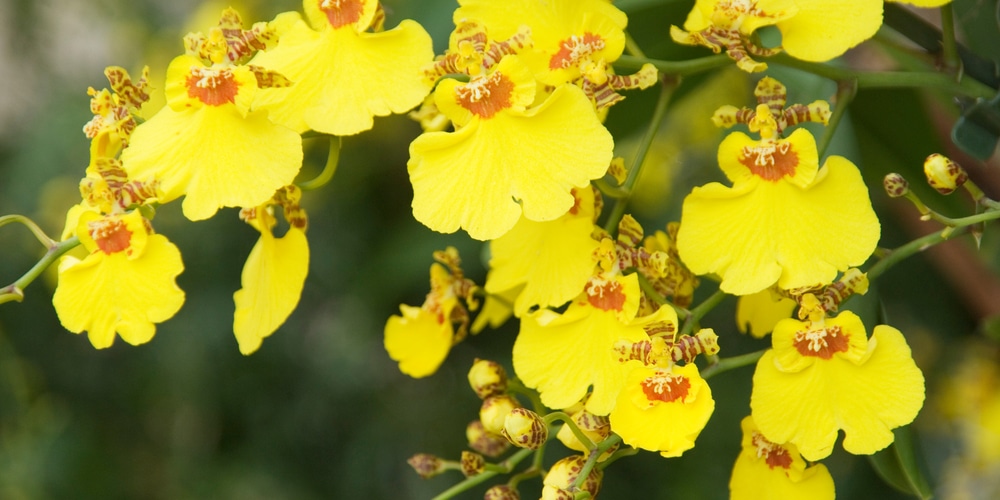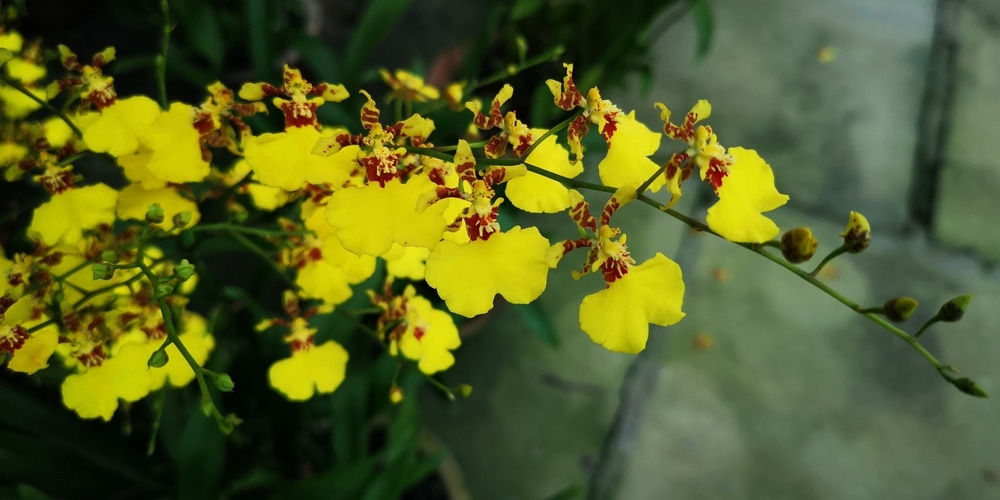Did you receive or buy a flower that looks like the Latin American dancer? Also known as Oncidium orchid, this plant was given the name “Dancing Lady Orchid” because it mimics the flawless skirts of the Victorian dancing maidens. It’s a plant that needs appropriate care, and as a gardener, you should be fully aware of ways to take care of the plant to provide an excellent growing condition.
Dancing Lady Orchid Plant Care Basics
The table below has basic information about dancing lady orchid to introduce you to this plant care:
Plant Type: Orchid, houseplant, tree-dependent plant
Botanical Name: Sharry Baby, Wydler’s dancing-lady orchid,
Exposure to Sunlight: Requires low to medium bright, indirect sunlight
Color: Green, yellow (flower color)
Soil Type: Well-drained soil
Water: Medium Amount
Preferable Fertilizer: Organic or Spray
Favorable Climate: Tropical Climate
Propagation: Crown Division
Height: 12-30 inches tall
Toxicity Warning: Toxic
Origin: Native to South America
Dancing Lady Orchid Diseases & Pests
Many pests can ruin the blooming process of the Oncidium Orchids. They may hinder your orchid plant from growing, turn the green leaves into yellow color or even brown, and even cause root rot. Here are the most frequent orchid diseases:
Orchid tip rot: This disease causes the tips of the leaves to turn brown and die. It usually starts from the flower stem and stem base, but it can also start from the lower leaf surface. The affected area turns brown and dry. This is a common problem with Oncidium Orchids, mainly when they are grown in areas with high humidity and low temperatures.
Root rot: This disease attacks the roots of an orchid plant and makes them soft, brittle, or completely dead. It is caused by fungi that infect the roots during their growth cycle. The infection can be caused by excessive moisture, poor drainage, too much fertilizer, or waterlogging of the soil.
Fungal diseases: These are caused by fungi that attack the roots of the orchid plant. They can cause the leaves to turn yellow and die, giving a very unattractive appearance to your orchid plant. The fungus usually enters through the roots and starts attacking different parts of the root system. It can also enter through wounds in the leaves and stems, which happen when you prune your orchid plants.
Powdery mildew: This fungal disease causes white powdery growth on leaves and stems. It is caused by a fungus called “Colletotrichum” (a type of “Oidium”), which is also known as “honey fungus.” Powdery mildew can also cause the leaves to turn yellow and die. It often affects orchid plants grown in areas with high humidity and low temperatures. The fungus can also enter through wounds or cuts in your orchid plant’s leaves, stems, or roots.
Black spot: This disease is caused by a fungus called “Plasmopara viticola,” which can be found on the surface of the leaves and stems of an orchid plant. The spots may look like tiny brown spots and are actually caused by spores from another fungus that infects your plant.
How to care for Dancing Lady Orchid
Here are tips on how to care for the Oncidium orchid properly:
Soil Requirement
The plant requires acidic soil with good drainage that makes the roots visible. The orchid will not grow well on soil with a high concentration of organic minerals that retain enough water that the plant needs. Therefore, the soil can be mixed with sphagnum moss, orchid bark, and even fern fiber to provide aeration and good drainage.
Fertilizer Requirement
Organic fertilizer is considered the best for Oncidium orchid. Sure, you can use ordinary granular potting fertilizer or liquid fertilizer, but it’s better if you can use organic fertilizers instead because it encourage the potting mix or soil mix to be healthy and rich in nutrients. Ideally, the spring and summer seasons are the best time to apply the fertilizer for the plant.
Besides that, a little bit of nitrogen-based fertilizer will also help the plant develop its roots faster, but you don’t have to overdo this as it’s still an herbaceous plant and not a flowering one.
Light Requirement
The Oncidium orchid requires bright indirect sunlight. You can place the plant near a window or artificial light source. But you must make sure that the light is not too strong, especially if the plant is located in direct sunlight. The plant needs to be able to adapt to various lighting conditions so it won’t be stressed during flowering.
Watering Requirement
The Oncidium orchid needs enough water and not too much water. If you see that the soil becomes dry or there’s no wet spot on the soil, then we suggest watering it thoroughly. Overwatering will cause root rot and root disease that will eventually lead to the die-off of the plant. You can also use a watering can to water the plant but use a gentle, slow, and steady water flow.
Potting Mix Requirement
The potting mix you use for your Oncidium orchid should be rich in nutrients and have good drainage. You can also mix about 50% orchid bark and sphagnum moss combined with peat moss, perlite, vermiculite, and medium-grade sand. You can also use terra cotta pots if needed. The potting mix should be well-drained so that air can get inside the pot to provide oxygen for the plant’s roots. Besides this, you also need to provide some kind of fertilizer for the plant.
Temperature Requirement
Like other plants, the Oncidium orchid needs to be kept in a warm place. A temperature range of 70-90°F (21-32°C) is ideal for the plant and should not drop below 50°F (10°C) at night, and below 45°F (7°C) during the day. If you’re keeping your plant indoors, try to keep it near windows that allow sunlight into the house. If you’re keeping your plant outdoors, then try to put it in an open place where it can catch some direct sunlight.
Humidity Requirement
The Oncidium orchid needs high humidity levels because they are epiphytes, which means that they grow on trees and not on the ground. Therefore, the higher the humidity level, the better the optimal conditions you’re giving to the dancing ladies. You can mist the plant once in a while, but don’t let the water cover the plant’s leaves.
Propagation Method
The Oncidium orchid can be planted or propagated by dividing another plant. To avoid injuring your orchid, split the stems apart or use a sterile blade to cut through the stem. Be careful not to injure the roots to avoid root rot. Repot these parts in different pots and treat them as if they were new plants. The seedlings can be grown in a pot and then potted into their permanent pots. They can also be grown on a tree trunk or any other suitable place where they’ll have enough sunlight and water.
Dancing Lady Orchid: Bottom Line
There are approximately more than 25,000-30,000 Oncidium species of oncidium plants. Typically, the Oncidium orchid is an epiphytic plant that means that it can grow on trees, but there are some varieties of Oncidium orchids, which are terrestrial plants; they grow on the ground. They have long stems and leaves of different shapes with a unique flower shape, with the upper portion of the lip wider than the lower portion. Also, they have short spurs at the base of the leaves, and the flowers have various colors like purple, pink, white, yellow, and orange. The Oncidium orchids are found in tropical regions of Southeast Asia, Malaysia, Northern Australia, and New Guinea.


